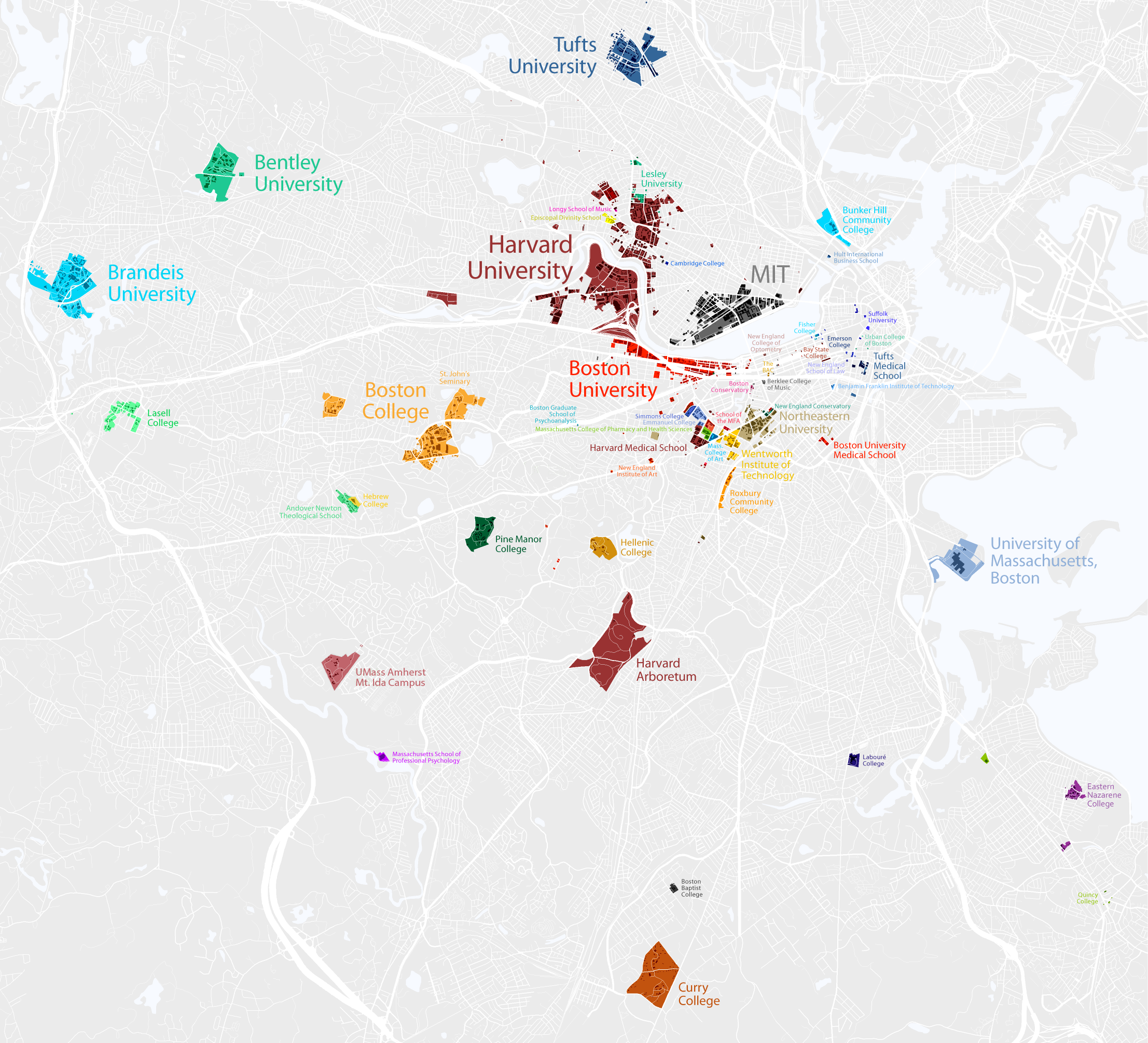Athens of America

Boston has long been called the “Athens of America,” a tribute to its rich intellectual and cultural legacy. The city is home to some of the world’s most prestigious universities, museums, and libraries, earning its reputation as a center of learning and enlightenment. Like ancient Athens, Boston has fostered great thinkers, artists, and leaders who have shaped the nation’s history and ideals. Today, its thriving academic, literary, and artistic communities continue to make it a beacon of knowledge, creativity, and civic life.
- Colleges in Boston Metropolitan Area
- There are a total of 52 institutions of higher education in the defined region, including four junior colleges, 15 colleges that primarily grant baccalaureate and master’s degrees, eight research universities, and 22 special-focus institutions. Of these, 49 are non-profit organizations while three are for-profit businesses, and 47 are private ventures while five are public institutions (four are run by the state of Massachusetts and one is operated by the city of Quincy).
-
Abundant in Medical History
- 1846 Ether
- William Morton, a local dentist, for the first time demonstrates the use of inhaled ether as a surgical anesthetic
Massachusetts General Hospital – Ether Dome
- William Morton, a local dentist, for the first time demonstrates the use of inhaled ether as a surgical anesthetic
- 1848 Medical School for Women
- BU Chobanian & Avedisian School of Medicine -The New England Female Medical College was founded, becoming the first institution in the U.S. to train women in medicine and graduated the first black female physician, Rebecca Lee Crumpler.
- 1890: First Native American Physician
- BU Chobanian & Avedisian School of Medicine – The first Native American physician, Charles Eastman, graduated from BUSM. He was featured as the central figure in “Bury My Heart at Wounded Knee.
- 1896: First X-ray presentation at a Medical Meeting
- BU Chobanian & Avedisian School of Medicine – First X-Rays in Boston by Francis Williams (need verification) who also became the first physician to show x–rays at a national medical meeting in the United States. he reported the findings in a patient with TB
- 1897: First African-American psychiatrist
- BU Chobanian & Avedisian School of Medicine – First African-American psychiatrist, Solomon Carter Fuller, graduated from BUSM.
- 1919 Infant Formula
- Similac – first infant formula developed at the Floating Hospital for Children (Tufts Medical Center).
- 1938 Pediatric Cardiac Surgery
- Boston Children’s Hospital – Robert Gross, MD performs the world’s first successful surgical procedure to correct a congenital heart defect.
- 1942: First GI Section
- BU Chobanian & Avedisian School of Medicine – First section of gastroenterology in the U.S. was established at BUSM
- 1944: First Studies in Penicillin
- BU Chobanian & Avedisian School of Medicine -First studies on the use of penicillin in civilians with infectious diseases
- 1944 Conception Outside the Human Body
- Harvard University – First conception outside the human bodyRock and menkin successfully fertilize an egg in a petri dish –
- 1948: Framingham Heart Study
- BU Chobanian & Avedisian School of Medicine -First medical school to work with the U.S. Public Health Service National Heart, Lung, and Blood Institute to identify risk factors for cardiovascular disease, creating the Framingham Heart Study
- 1949 Polio Virus Culture
- Boston Children’s Hospital Polio virus cultured in 1949 leading to the development of the vaccine by John Enders, PhD, who won the Nobel Prize in 1954. Enders’ group also credited with culturing the measles virus and developing the measles vaccine.
- 1954 First Organ Transplant using a Live Donor
- Brigham and Women’s Hospital – a team led by Joseph E. Murray, MD, J. Hartwell Harrison, MD and John P. Merrill, MD, accomplished the first successful organ transplant involving a live donor.
- 1958 Immunosuppression.
- Tufts Medical Center- Developed and coined the term immunosuppression. The discovery enabling progress in the field of organ transplantation reducing the chances of organ rejection.
- 1962 Limb Reattachment
- Massachusetts General Hospital – first successful reattachment of a severed human limb, involving the arm of a 12-year-old boy.
- 1986 First cancer gene.
- Massachusetts Eye and Ear isolate the first hereditary human cancer gene (retinoblastoma gene) providing a genetic insight of cancer
- 1980’s T cell role in immune system
- Dana-Farber Cancer Institute – immune system is “turned on” by helper T cells and “turned off” by suppressor T cells with significant implications of how the immune system functions
- 1846 Ether
-
- 2008: Green Fluorescent Protein
- BU Chobanian & Avedisian School of Medicine – Nobel Prize for Chemistry awarded to Osamu Shimomura for his work on green fluorescent protein
- 2008: Green Fluorescent Protein
-
-
- List of Nobel Laureates
- first fertilization of an ovum in a test tube
- first successful human-organ transplant
-
